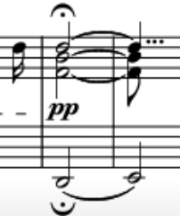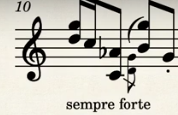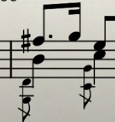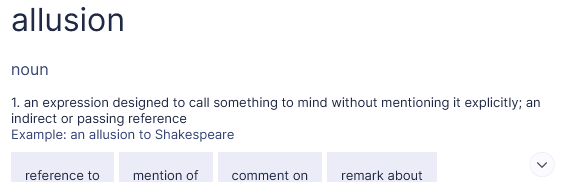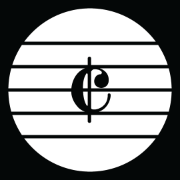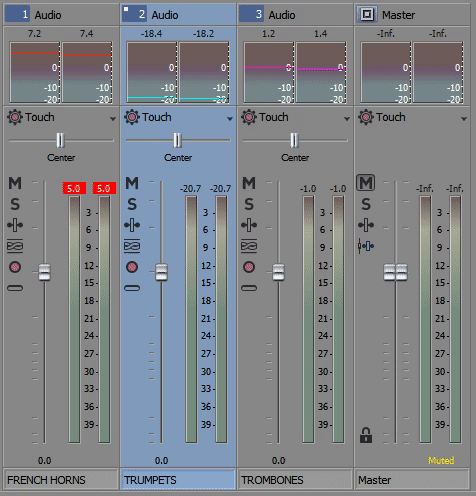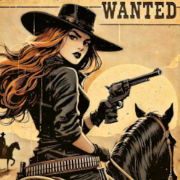Leaderboard
Popular Content
Showing content with the highest reputation since 04/20/2025 in Posts
-
The Image in G major is the third piece of the four piano pieces I wrote for relaxation after writing the very heavy String Sextet. I try to do something a bit different than the previous two pieces, as I actively use more quartal chords and pentatonics in the whole piece, and also invite a bit of impressionistic chords. This is my personal favourite of the set. Here is the score and YT video: (Final) Image in G major.pdf Like the previous pieces, this one also comes from recycled materials. It comes from an unfinished Piano Suite I composed in 2016 Jan, but only with fragments of it including the first few bars, b.35-38 LH melody and some parts of b.58-72. Don’t know why I went for pentatonics that long ago LoL! One thing to note: b.43-46 is probably inspired by @Fugax Contrapunctus Pabio’s mention of Joe Hisaishi in his review of my Sextet, plus my recent listening experience of his music while watching Miyazaki’s films. Hope you enjoy this small piece! Henry4 points
-
I finished the other two movements hooray!! Here's the YouTube upload. Please let me know what you think so I might apply the advice for future piano works 🙂 As for the piece itself, it's so personal to me I'm not willing to change anything, though I recognise it's not flawless. I think it is my very best piano piece and I'm extremely proud of it despite its issues. I'll do a rundown of the piece real quick so ya'll know what to expect. Movement 1. Sonata form, both themes are derived from the same rhythmic idea. A theme for desolation and a theme for consolation, which alternate in rotations becoming less and less certain until neither resolve. closes on a 6 4 chord. attaca into... Movement 2. Ternary form. A is a waltz with violent interruptions. B is more restless and dramatic. The return to A is based on first movement closing 6 4. Ending of A is infected with B motifs. Closes with a satisfying cadence at last. Movement 3. Ternary form. This movement is meant to be "looking back" at the events of the previous movements. B section is turbulent again. A section returns. The movement closes with a chorale "prayer." attaca into... Movement 4. Sonata form. Opens with a return to the consolation motifs from movement 1. First theme is dramatic and modulates constantly. Second theme is a combination of consolation and prayer. The climax of the development (and I think the climax of the whole piece really) with the minor version of the consolation theme from the first movement is in E minor which is a tritone away from tonic key. Recap has no proper second theme, only fragments. It ends resolved on a single note all by itself. All alone. Thank you for listening and for any feedback :33 points
-
Hi @FILMSCORE! Nice orchestration! To me it has the hallmarks of a charcuterie of different orchestral textures from the classical orchestral literature. The beginning starts as if you're going to give us a trial run of all of your orchestral samples for us to test out how your orchestral libraries sound. There's a clear allusion to Holst's Jupiter from the Planets Suite (around the 1:00 mark although the melodic content in the brass is a bit different). I'm not sure what the fanfare near the beginning is from. The harp is often too loud in comparison to the rest of the instruments and is not doing its signature glissando flourishes that could give your orchestration so much more color. Although it might be really taxing on your software/equipment to render quick harp glissandi with so much reverb. It might be easier to render the harp and the rest of the instruments with less reverb especially if they're all playing together. Thanks for sharing!2 points
-
ello everybody, I've spent many months working on three short new piano pieces for beginning to intermediate students. These are originally intended for children to play, but could also be for beginning adults. In these pieces, I've also tried to discover my own voice and style, do let me know how I've done in those areas. Other feedback related to technique, harmony and playability would be much appreciated. Poem 1: "based on a theme by Beethoven", updated score Poem 2: "the quirky detective", updated score Poem 3: "the crazed capybara", score2 points
-
Hi @ComposaBoi! I know I've heard the 1st movement before but am not sure if I reviewed it. I don't hear the following chord in your performance: I just hear a Db both in the left and right hands. Also, didn't you mean to mark this as 8vb? 8vb means an octave lower while 8va means an octave higher: That aside, I find the main theme to be so happy-go-lucky in comparison to the bleak introduction! LoL I think the way you present the main theme in measure 78 is more appropriate to be the main theme proper, being darker and more suited to follow the bleak introduction. I know you said you won't be changing it but I'm going to give you my impressions nonetheless. The version of the main theme at 151 is also nice - not overly happy-go-lucky but rather, bittersweet. The version of the main theme at 220 where it is used as a modulating sequence is really good! I much prefer this treatment of the happy-go-lucky material as it sounds more developmental and suited for modulation. When you return to the material of the bleak introduction the 2nd time it sounds really empty and like the momentum of the piece just stops and falls dead (especially with the left hand staccato notes). The 2nd movement waltz sounds like it really flourishes perfectly out of the 1st movement! It really creates a lucid listening experience. The only thing that brings me out of it is the allegro furioso. I think it sounds way too fast and intense for the bittersweet mood you set with the beginning of the waltz. I like how you reference back to your 1st movement material with the molto meno mosso part. With how fast and furious this part gets it's amazing that you managed to perform it! I think bringing back the dreamy main waltz theme towards the end really releases some of the furious tension you build up with the fast tempo sections. Great job with these two movements! I'm looking forward to reviewing the last two at another time. Thanks for sharing!2 points
-
If you were going for a movie score feel then you got it, because it sounds like the soundtrack for a Marvel movie (not meant as a slight). I do agree with what Peter is saying about the accompaniment overpowering the melodic lines. This is something I have struggled with as well, in sometimes layering too much, and ending up with a muddy mess. It sounds good, but it hinders the ability to focus. I would suggest going through, the softer moments especially, and seeing where you can edit out some of the underscoring, to let the melody shine through a little better.2 points
-
Hi everyone, I would like to share with you my first major composition: a string quartet. My compositional style is evident in it, which is quite unusual, but at the same time I think it is accessible to a wider audience. I'd appreciate it if you gave it a listen! Thank you! https://youtu.be/WPfU9OKB8Aw?si=EFZEiZDdlTbWXOnu2 points
-
Here is my 3rd and latest composition. It is a tone poem based on a poem by the first european female author, Sapho. I hope you like it and I would like some feedback. Here is the poem "Hymn to Aphrodite" in English. Iridescent-throned Aphrodite, deathless Child of Zeus, wile-weaver, I now implore you, Don’t–I beg you, Lady–with pains and torments Crush down my spirit, But before if ever you’ve heard my pleadings Then return, as once when you left your father’s Golden house; you yoked to your shining car your Wing-whirring sparrows; Skimming down the paths of the sky’s bright ether On they brought you over the earth’s black bosom, Swiftly–then you stood with a sudden brilliance, Goddess,before me;Deathless face alight with your smile, you asked me What I suffered, who was my cause of anguish, What would ease the pain of my frantic mind, and Why had I called you To my side: “And whom should Persuasion summon Here, to soothe the sting of your passion this time? Who is now abusing you, Sappho? Who is Treating you cruelly? Now she runs away, but she’ll soon pursue you; Gifts she now rejects–soon enough she’ll give them; Now she doesn’t love you, but soon her heart will Burn, though unwilling. “Come to me once more, and abate my torment; Take the bitter care from my mind, and give me All I long for; Lady, in all my battles Fight as my comrade.2 points
-
Hi again @UncleRed99! My perception hasn't changed by much, but I think I can better explain why I perceive the piece the way I perceive it. I can hear that you definitely intend there to be a main melody leading the piece from beginning to end but there are a few factors that (in my opinion) prevent this from being a lucid listening experience for the listener. Sometimes the melody is just overpowered by chords in the orchestra played loudly while a single solo instrument is playing the melody and it doesn't really get heard. The most obvious example being the bass clarinet melody in bar 5. There are also other examples where you kind of create a polyphonic/heterophonic texture where it becomes kinda hard to hear which instrument is supposed to be the focus or main melodic line. There are ways to make polyphonic/heterophonic textures work though but that would necessitate them being more self-similar and use a higher economy of means to achieve a more obvious audible relation to each other. While if that isn't achieved, then it can end up sounding like you're just noodling around in a certain key. Although I don't want to neglect to give you credit where credit is due. You definitely have a recognizable motif that permeates this piece: It's just that this is a very short recognizable motif that is just repeated throughout the piece without really being used to develop it by using it as the dynamo and origin of all of your other melodic material. When the other material isn't connected together it can sound dissolute and lacking in direction or focus. That's my perception of the piece. I'm glad you're so determined to continue to improve and I hope some of what I said can help you further on your journey!2 points
-
I hope you will consider taking another look at this, whenever you’re able to find the time for it 🙂 I’ve made many improvements to it since. I know that my form / structure is a bit abstract/abnormal. I met a friend on Musescore back when I wrote “The Long arctic midnight suite” in 11/8 time, and he also edited my score “Lamentation” on his own volition. we sat in a discord call for like 5 hours yesterday, analyzing one another’s scores. He’s a composer and is on his way to getting his masters in composition, and he performs as a classical pianist. He gave me some material on Binary and Ternary Form structure, and stated that I’d probably be most interested in Sonata structure.. (all of which I was clueless about until now 😅) He says he thinks this is one of the better compositions I’ve written, based on the modulation, and the chord progressions I’ve used, as well as the complexity in voicings within the chords and the melodic lines. Although, the form could’ve been executed in a way that would’ve been easier to digest. He called this “through composed” mostly, with some returns to a main motif. with this context, I believe what I’ve done, here, could be better understood, in addition to the changes I’ve made. I value your feedback as well as @Henry Ng Tsz Kiu’s feedback in this forum, given how methodical and detail oriented you both tend to be. I’m just looking to improve upon what I already know, learn what I do not know, understand what I have accomplished effectively, and have things to reflect on in regard to what was ineffective or poorly executed. i know I’m just an autodidact who does this as a hobby, but I’m a bit of a perfectionist who’d love to be that outlier independent composer who can write scores that are educated, well executed, and well received by the internal industry audience. 🙂 thank you in advance, Peter !2 points
-
So this is something i have worked on for four years now. I was inspired to write it, as ballets (Rite of Spring, Petrushka, Firebird, Romeo and Juliet, Swan Lake) are some of my favorite pieces of music. I wanted to see if I could carry a narrative through the music. It's long, it's a full 2 hour ballet. I fully understand most people will not listen to it, but if you have sometime. I wanted to have the score ready with it, but I had an unfortunate incident with a failed hard drive, that claimed three of the scenes. I hadn't realized they were not backed up, so I'm in the process of reconstructing them from the audio. I've included a program for you to follow along with. Roles: Tove - Youngest child of a peasant family Bjørn - A prince, cursed to be a bear during the day Åge - Father of a peasant family Liv - Mother of a peasant family Revna - A witch who cursed Bjørn Estrid - A young maiden and one of three sisters Frida - A mother and one of three sisters Gudrun - An old crone and one of three sisters East Wind, West Wind, South Wind, North Wind Tove’s brothers and sisters Revna’s servants ACT 1 Scene 1: During a great famine, a peasant (Åge) is searching through the woods, looking for food. Suddenly, a monstrous white bear (Bjørn) appears before him. The bear offers to give him all the wealth and food he could ever need, in return for his only daughter. Although troubled at the thought of what the bear will do to her, he accepts, knowing that his wife and other children will starve if not. Scene 2: Upon returning home, the peasant tells his family of the bear's offer of wealth and food. His wife (Liv) and sons are shocked that he has traded away his only daughter. His daughter (Tove) is horrified that her father has given her away to this magical bear but accepts her fate, knowing that it will save her family from starvation. Bjørn comes to collect his payment and bestow upon the family what he has promised. Before their eyes, their shack is transformed into a mansion, filled with gold and endless food. Tove reluctantly follows Bjørn into the forest. Scene 3: Bjørn and Tove travel through the woods, with few words spoken. A pack of wolves attacks, but Bjørn drives them off. As they reach the edge of the woods, Tove suddenly sees a magnificent castle. Bjørn informs her that this will be her new home. He tells her that the only rule she must follow is to never light a candle during the night. Scene 4: As night falls, Tove prepares for bed and puts out all the candles in her room. She climbs into bed in the darkened room and begins to drift to sleep. She is startled by someone entering the room. She calls out, but no one responds. She goes to light a candle but then hears the voice of Bjørn, reminding her that she must never light a candle during the night. After a while, she drifts to sleep. ACT 2 Scene 5: Almost a year has passed, and Tove has discovered that Bjørn isn’t the monster she first thought him to be. She finds herself beginning to feel a deep affection for him, just as she notices that he also is falling in love with her. Scene 6: One day, Tove asks Bjørn if she may visit her family, as she is missing them. He grants her wish but makes her promise that she will not speak to anyone about her life at the castle. Tove returns to her family, and they throw a celebration in honor of her visit. During the celebration, her mother continually tries to ask her about what goes on at the castle, but she manages to avoid the questions. After the party has finished, Liv corners her and demands answers to all of her questions. Tove reluctantly tells her mother about the mysterious man who enters her room each night. Her mother tells her that after the man has fallen asleep, she should light a candle so she can see who it is. Tove tells her mother that she is forbidden to do that, but her mother insists that no one will ever know. Scene 7: Back at the castle, the pattern of events continues as before. During the night, the mystery man enters her room and falls asleep in the chair. After a few nights, she decides to do as her mother has said. She waits a long time after he has fallen asleep and then lights a candle. She leans over his body to see the face of a beautiful young prince. She is so captivated by his face that she doesn’t realize that melted wax starts to drip from the candle. It lands on the sleeping man, the heat waking him from his slumber. He sees her looking at him with the candle and jumps from the bed. He explains that he is Bjørn, and a witch (Revna) had transformed him into a bear because he refused to marry her. Under the curse, he must spend each day as a bear, only becoming a human at night. The only way to break the curse was for a woman to fall in love with him without ever looking at his true face. Only by earning her trust could the curse be broken. After apologizing for having failed her and himself, he must now marry Revna and be imprisoned in the house that is east of the sun and west of the moon for the rest of his life. The room suddenly goes dark, and as light reappears, Tove finds herself in the forest, alone. ACT 3 Scene 8: Tove is wandering the woods, grieving over losing Bjørn. During the many months with him, she had come to care for him and realizes what she has now lost. While walking through the woods, she comes upon a young girl (Estrid), whose leg is trapped under a fallen tree limb. She helps free her, and the two begin to talk. Tove asks her if she knows the way to the House east of the sun and west of the moon. Unfortunately, Estrid has no idea, but she magically conjures a horse that will carry Tove to her sister (Frida), who may know the way. She also gives Tove a golden apple as thanks for having freed her from the tree limb. Scene 9: The magical horse carries Tove to a lake, where she hears cries for assistance. She sees a mother, holding her baby, trapped upon a rock in the lake. The woman tells her she is unable to swim and fears her child will drown. Tove crosses the river to the rock and helps the mother and child safely back to the shore. She discovers that this woman is none other than Estrid’s sister Frida. Tove asks if she knows the way to the House east of the sun and west of the moon, but just like her sister, Frida has no idea. However, she conjures a magical boat that will carry Tove to the other side of the lake and to the house of her other sister (Gudrun). She tells Tove that if anyone knows, it will be Gudrun, as she is the eldest and wisest of the three. She gives Tove a golden comb as thanks for saving her and the child. Scene 10: The magical boat carries Tove far across the lake. In the distance, she sees a small hut that is in flames. As the boat comes to the shore, she hears the screams of an old woman from inside the burning house. She runs inside and drags the old woman out just as the hut is completely consumed by fire. She discovers that this old crone is none other than Gudrun, the third sister. Tove pleads with her to tell her the way to the House east of the sun and west of the moon. Gudrun tells her she must travel to the place where the winds of the east, west, north, and south meet together and ask for their assistance; only they can help her find the way. She then conjures a great bird to carry Tove to the highest mountain peak and gives her a golden needle and thread in gratitude for saving her from the fire. Scene 11: As Tove approaches the summit of the highest mountain, she sees four old giants arguing with one another. The bird lands, and she approaches them, asking if they know where the four winds could be found. One of the giants tells her that she is in their presence already, as the other three try to interject. She realizes that it is their constant arguing and screaming which produces the winds. She asks them if they can help her reach the House east of the sun and west of the moon. The East, West, and South winds tell her they know not the way to find it. The North wind proudly tells her that he once carried a sparrow to this far-off land. She asks if he can take her there as well, and with a gentle breath, he launches her into the sky. ACT 4 Scene 12: Tove awakes in a field, thinking she has dreamed everything that has happened, but then sees a massive house, with the sun to its left and the moon to its right. As she approaches the house, she sees a woman (Revna) collecting mushrooms. She asks if there is a young prince at this house. Revna asks why she wants to know. Tove offers her a golden apple if she may spend the night with him. Revna agrees to this deal but then gives Bjørn a sleeping potion so that he won’t see this beautiful girl. Scene 13: Tove tries again the next night, after offering the golden comb as payment, but again Bjørn is drugged. As Tove cries over his body, telling him how she loves him and regrets not trusting him, the servants overhear Tove’s cries each night. Scene 14: They decide to tell Tove about the sleeping potion. After receiving a payment of a golden needle and thread, Revna once again conspires to drug Bjørn into sleep. However, Tove has arranged for the servants to switch the drink. Bjørn goes to sleep, while Revna believes she has drugged him. Scene 15: As Tove enters the room, she once again declares her love for Bjørn and tells him to wake from his slumber. Bjørn opens his eyes and, upon seeing Tove, tells her that they will be together forever. Just as they go to kiss, Revna rushes in to stop them, but they kiss, and Revna bursts into flames as the curse is broken. They free all of the servants and together leave the house east of the sun, west of the moon, never to return.2 points
-
anyways, this is a tone poem that is performed like any other concert piece. The piece itself is pretty long and every act spans from 18 to 30 minutes each. It should be performed like an opera or a ballet, despite there being no acting or dancing involved. instrumentation notes There are three oboes in total. All three double on bass oboe in the first movement. • The first clarinet part has two players: • One playing the upper line. • One playing the lower line, doubling on piccolo clarinet in the first movement. • Throughout the piece, both oboes and clarinets will need to switch back to their primary instruments at various points. This is act one out of four and I am still revising them so I could put them on here anyways here are the performance notes: The act opens with Prelude to the Heart, hinting at the emotional turmoil ahead. Ross’s theme, The Solitude of Ross, explores his quiet longing, while The Jesters (Tobias and Percival) add lighthearted moments of friendship. The arrival of Aldric, The Manipulator, disrupts Ross’s world, introducing him as the antagonist who plays mind games with Ross. Meanwhile, The Council of Shadows represents the complicated dynamics of Ross’s social group. Orson, The Disruptor, causes further tension, while The Mocking Wind symbolizes the cruelty Ross faces. However, it’s Selene, The Light in the Mist, who captures his heart, leading to a deep emotional connection in The First Glance.Ross’s feelings intensify in Eclipsed by Desire as he falls deeper in love. In the midst of his growing affection, The Gathering brings subtle tensions to the surface, and The Quiet Northern Winds reflect Ross’s inner turmoil.The turning point comes with The Shadows of Mockery, as Malcom and his followers begin to torment Ross, leading to The Great Deception—a moment of cruel betrayal. Ross retreats into Reflections in Silence, contemplating his situation, while at the Spring ball intensifies the emotional conflict. The act closes with Florence’s introduction as The Siren’s Call, adding another layer of complication to Ross’s feelings for Selene.2 points
-
2 points
-
Hey @Fruit hunter! Very interesting music! I think when writing a programmatic work like this, it is important to be able to involve the audience more in the story that you want to convey with the music. In other words, you want to give the audience an idea of what it is that they should be listening for. I can see in your score that you are working with thematic leitmotifs. As a casual first-time listener to this work I find those themes hard to pick out and hear. Perhaps, you could give the listener an introduction to each melody in isolation and associate it clearly in the audience's mind with the character you want it to represent? Maybe you already do that and I'm just missing it or not getting it? One thing that certainly seems to be the strength of the composition is the orchestration though! Thanks for sharing!2 points
-
Hi @BipolarComposer! I like the mood you set here! It's like a mix of music from the classic videogame "Metroid" and a bit of Elliot Goldenthal. The latter half is quite different from the beginning which sets a menacing but mysterious mood. But the end is like a release. I like it a lot! Thanks for sharing. I hope you don't end up removing it sometime in the future - it deserves to be heard by the community! Also, to encourage more participation and interaction between you and the people who might listen and review your work you could give a ❤️ or a 🏆 as a reaction to our reviews! And btw - Happy Easter!2 points
-
I got a ping today that I am not active on here much anymore. Last August, I became bedbound with ME/CFS and have seen a steady drop in my abulities to do anything. From 50% functioning, to 40 to 30 to 20 to 10 to 5. Some days I can barely lift my head to eat. There is talk of putting me in a nursing home when my mom goes back to work this fall. I’m only 22! Oobleck, which I’ve posted here before, was written primarily in the first month of my illness. Before things became really bad. When I was still hopeful I would be better by “X” date. “It’s just the flu,” and “I’ll be ready to go back to school by fall break,” turned into a slow melting away of my entire life. Moving back home with my mom, leaving my friends, my college city, my life I had built, and having to start completely from scratch with a body that leaves me in 9/10 pain and dysfunction daily. It is a very potent work. Perhaps my first real “piece of art.” I am proud of creating something that is truly me. It is not about enjoyment, it is about the experience. I can dub the work as “Mahler, but with quarter tones.” I won’t be writing or doing much of anything for the next while. My life is too covered in oobleck. Program Note: The term oobleck is a type of substance that, when supported with pressure and force, is a solid. However, as soon as this support is removed, it oozes into a sticky liquid. Because of this, the oobleck always feels like it is on the verge of oozing apart into a mess of gunk. Dr. Seuss coined the term, introducing it in his story, "Bartholomew and the Oobleck." Its manifestation in the story is an evil, sticky substance which covers the kingdom it rains down upon. "Oobleck" is an aural exploration of a familiar musical world tainted by oobleck.2 points
-
2 points
-
Hi again @Dima Kravets! I agree with what @luderart has said above about the difficulty of some of the double and triple stops. Including consecutive double stops that can be really difficult as well! Such as these: and these: In the first image the D and G have to be played on the G and D strings respectively and right after using those two strings for the C and Ab. In the 2nd image the G and D open bottom strings are played before moving to a parallel fifth on the A and E strings playing a B and F# which have to be barred at the same location on the finger board which can be difficult. I also agree that a real performer could definitely breathe more life into the composition with their interpretation. But it's a thousand times easier to make a musical interpretation if it is clear to the performer that the composer already has an idea of how the piece can be expressed in a musical way. This is especially important for pieces that are for a solo instrument because the soloist is tasked with keeping the momentum and musicality of the work all on their own which is much more intensive than collaborating with another performer. The soloist is asked to "make something out of the work" that in many cases has never been performed before. So having a good idea of what you want as the composer can really help the performer out and facilitate a future performance. And making a good rendition with lots of tempo changes and musical indications as to how the piece should sound even in electronic form is important as well (perhaps as a selling point to get a performer convinced to perform it). I see from your profile that you specialize in chamber music so you probably already have a good idea about that. But when you say things like: it makes me think that you don't see the point or value of making a realistic rendition, which is a shame. Needless to say, the piece sounds very mechanical throughout and could stand from some humanization and TLC to improve it. But it's better to already be thinking of those things as you're composing it rather than having to go back and revise a piece that wasn't conceived musically to begin with. That's just my own perception of the piece however. I look forward to hearing more of your contributions to the forum (as well as potentially your opinion about other composers' works on the website!) Thanks for sharing. P.S. I'm sure the reviewers of your work (including myself) would appreciate a ❤️ or a 🏆 reaction/acknowledgment of their time and effort that they took to listen and formulate a response. It would really help our little musical community flourish! Thanks in advance!1 point
-
Thankyou 4 your Indepth-Review, i was shocked to see it. Thankyou............ The Harp plays only Once, at the Start of the Track with the Timpani, Primarily to initiate the "SIGNATURE" Thankyou..........The software can take "BOTH-BARRELS" ...... he he , quick harp glissandi is possible, and there used in other productions already posted. Thankyou..........All Production-Trax posted ,are using a "RICOCHET" Reverb, and there is a problem with it, as this software is a Classified-Alpha/Beta version. ---------------------- I had to Look up 2 words that you used, as iv never heard them B4.............. But now i know , & Thanx again 4 your Detailed Review.1 point
-
It's a limitation of how I use MS probably. irl I would couple the manuals to the pedalboard so the bass would sound more prominent irl1 point
-
Hi @Ho Sen Ken! Wow! What a great and intense Bartok-like piano banger! It reminds me of one of Bartok's early works Scherzo in E minor for Piano. Although admittedly, your work is a bit more similar to later more harmonically adventurous works. I'm looking forward to hearing more of your contributions to the forum (and besides sharing your music you could also tell us what you think of other composers' works!) Thanks for sharing! To reward those of us who have taken the time to listen and review your pieces, you could also leave a ❤️ or a 🏆 reaction to support our community and let us know that you acknowledge our time and effort we've put in towards reviewing. I'm sure the people above who have reviewed your piece as well as myself would really appreciate it! Thanks!1 point
-
Hi @PCC! Great job with this arrangement! I was having trouble hearing the bass part in some of the sections so I turned on my bluetooth speaker but it kept glitching out like crazy with the sound cutting in and out constantly which made it unlistenable (and this happened only in the "principale" sections - it played the rest of the piece just fine for some reason). So I know that my inability to hear some of the bass parts was in part due to the speakers on my Chromebook. But I also question whether there might be something in the recording itself that makes my bluetooth speaker behave the way it did in the principale sections? Either way - I think I got the gist of your intent in how it's supposed to sound. Thanks for sharing!1 point
-
Thanks you for your detailed analysis. I definitely will review/assess the triplet figure in the strings. And I am so very pleased you found the work appealing!1 point
-
Thanks for taking the time to comment on my work. I will review/reflect the percussion line. Mark1 point
-
Hey Henry! A very nice piece of impressionistic music! I truly enjoyed it. I love the tonic pedal point and the melody in the left-hand part of the A-flat major section. This piece gives me an oriental feel – it's much different from the other pieces you composed more than a year ago. Do you still write Classical-styled music, or have you transitioned to a new compositional style? I'm sorry for being quiet on this forum for a while - I needed to take a break from composing and work on bigger projects. Life's starting to get busy. Carl1 point
-
Hi again @Alex Weidmann! I like the ebb and flow of this piece! There's definitely a gradual rise and fall in dynamics that sounds very natural to the arc of the piece. What doesn't sound natural however is how the melodic line sounds interrupted or cut off by occasional staccato notes in the strings in the beginning. This is a problem that you soon rectify with the addition of more instruments playing the melody and a thicker orchestration. But I like the piece despite that - it makes me think of a peaceful and potentially life-bearing world in orbit around Tau-Ceti in the goldilocks zone for that star. Although, now that I read about it, the Tau-Ceti system is quite a bit older than our own solar system, so it's possible that it has already harbored intelligent life in its past. Musically it amazes me how you are able to make music out of the most random seeming musical gestures on solo instruments with a harmonic pad underpinning. It's so totally alien to the way I write music. You also make use of really alien sounding chords that I would never think of using (all of which is appropriate for a piece about an alien solar system I guess! LoL) Thanks for sharing!1 point
-
Hey @Alex Weidmann! I listened to the most recent update (#32). The main theme has the makings of a great feel-good space western! But, I do have to say that in my opinion, the key modulations in the piece (especially the last one at the very end) sound out of place and unnecessary, like you're changing the key just for it's own sake without really any real musical reason guiding that decision. Also, I like how the piece starts very underwhelmingly with really soft high strings and slowly builds up to the main theme first on trumpets and then scored more fully with strings on the main theme. But then, the arc kinda doesn't know what to do with itself after 1:07 because it feels like the climax of the piece has already been reached and the music doesn't know whether it wants to keep growing to an even bigger climax or die back down to a whisper. Those are my immediate perceptions of the piece. Thanks for sharing and let us know if your music ends up getting featured!1 point
-
I took the liberty of writing a short composition to test the different capabilities of the new Vienna Brass sounds from Musegroup, in collaboration with Vienna Music Library. My first impression was that the French Horn sounds, all of them, were FAR too quiet. I was forced to add a compression FX to it, cranked up quite high, with a +3.0 Gain just to hear it through the rest of the ensemble. But I think I got the sound dialed in just right here for the video. Figured I'd do everyone a favor and make a quick demonstration and provide my thoughts on it. Overall, I'd give the plugin a 5/10, in it's current state. I know its still new, so updates are likely on their way at some point in the future. Attacks on each instrument, as you'll hear, are a bit odd, and sort of like there's an accent or marcato mark on each note, except not as pronounced? I hope that makes sense.. lol I also noticed that when using Accents, they're either flat out ignored at times, or, they're over accentuated, to the point the instrument plays a "blat" rather than an accented note. Or, at lower dynamic volumes, they will be played as if it was notated "fp" just underneath it? Weird.. However I must say, it's WAY better than my previous experiences purchasing sound packages from MHub. CineBrass from MSounds, and Berlin Brass from MSounds were ABSOLUTE TRAIN WRECKS when I tried them out, a couple months after they released. Buggy as all hail, would randomly pitch bend notes longer than a dotted half note, or just outright play everything completely out of tune. (I have a demo vid somewhere that even shows that issue, I think... Can't recall what I did with that, but all you needa know is that it was HORENDOUS lol... This is a vast improvement that brings me some hope for future additions to the MS Library store. 🙂1 point
-
Its not enough to just HEAR the music, youve also got to SEE the music, and im not talking Notation-Score. Regarding the FINAL-MIX-DOWN , iv often thought to myself........... " Yeah that sound ok ".........Without even checking to see the levels-Balance. in the example below: 1: The French Horns were 5-db OVER 100% 2: The Trumpets were 27-db LOWER 100% 3: The Trombones were 6-db LOWER 100% The Final Result sounded imbalanced1 point
-
I have continuously had a problem where it fails to recognize that I have the libraries installed, so I have to open their stupid MuseHub program for it to rediscover them. The last time this happened about a month ago, the MuseHub site claimed I did not even have an account, so I suspected that now I may just lose access to the libraries I'd purchased. I emailed their tech support and got the most useless person in the world on the other side who I'm convinced wasn't even reading what I sent to him and was just throwing out pre-conditioned responses. Eventually, I took a gamble by going "Creating Account" and thankfully, it still had my information so that I could use the libraries until the next time it happens... Anyway, I really like the long articulations in the Berlin Strings and Winds and I've been using them on my upcoming album. They are a much cheaper alternative to the Kontakt libraries of course, but they too are woefully imbalanced. I have to crank the violas up in the mixer and turn the violins 1 down. Brass instruments do have some great sounds, but are rendered unusable by imbalances between articulations. It's unfortunate that Musescore 4 has been fumbled so badly and they seem to just not care about improving what seem to me fairly simple things to fix. If their customer service is an indicator, it seems that apathy is to blame.1 point
-
Hello! I've never heard that Brahms piece, I'll have to take a listen at some point You're probably right about those leaps being a bit difficult, but they should be doable with practice. I can do them and I'm far from a good singer 😅 A C# would work in m. 46 but I like the way it sounds to move from natural to sharp in the next measure. Thank you for the feedback!1 point
-
1 point
-
Thankyou for this "REAL-WORLD" review, as opposed to these current "Company paid reviews" example : " Its Amazing...Its Awesome...Its a No-Brainer ". .................Yeah you'd have to have no brain to believe it. Its only when you Trial these Personally, like you have............That you Discover the Real-World review. Iv included a mini-Selection of Brass sounds, thats currently used in a Restricted Software,thats in Alpha/Beta testing But most people know the difference between a Piano and Trumpet.....................its impossible to re-invent the Wheel.1 point
-
Hello everyone, I've been working quietly behind the scenes away from Young Composers for the past couple of weeks, working on my compositions and even having occasional practice sessions on my violin and piano. One day, I improvised on my piano and recorded it. I played back the video to myself and found the result so touching that I decided to create a complete composition of it on my Finale software. I'm really happy with this work and dream it will be the next "Song from a Secret Garden," both pieces having origins as solo piano pieces and eventually becoming full-blown orchestral works (in my case, "will" become). Yeah, that's a bit too ambitious, but a guy could always dream, right?! 😄 Your feedback is welcome!(: ~Frank1 point
-
Yo Arjuna! Yup I definitely learn from that 2nd movement of that random music for the pentatonicism displayed here! The Joke would be just a really straight forward daddy joke I guess lol! Henry1 point
-
Yo Peter! I don’t force myself to imitate Debussy though, his influence however must show in this. I am stupid in those errors, b.49 it should be Eb in LH, b.54 an Eb. These errors happen because I didn’t update my score after recording and nuancing the details lol. An additional error would be in b.45 when I erroneously played a C instead of F for right hand. It happens because it’s a manual playing error lol. Yeah it’s a norm for me to combine ideas together simultaneously haha, and those imitations are deliberate! I love the canon too, it’s the thing I can’t do 10 years ago! Henry1 point
-
Hi @Ferrum! Thx for your comment! That’s the first time I have seen you dropped comments on my works haha! Yup I wanna try a bit of the tonic pedal effect, maybe even a bit bitonal for a G pedal under an Ab major chord.That freaking quartal chord in b.33 is just a sudden thought when I reached that passage to modulate, and weirdly it works! I love that b.35 LH theme too, it’s a product comes from 10 years ago! The counterpoint in b.55 is new though, because I won’t have the technique for the canon LoL. I love the ending as well, I think a tonic chord ending would ruin the piece by sounding a bit too confirmed. I love you love the piece, thx for that! Henry1 point
-
Hi @user011235! The use of D minor reminds me of Brahms’s Lied on death, op.121 no.1: I like the first sentence with the repeated A, it depicts the stillness of death well. The ending of A and then lower an octave and then a fifth sounds a bit difficult for the vocalist for me. For me, maybe I would use C sharp instead of C natural in b.46. Thx for sharing! Henry1 point
-
Hi @Frank Normandy! I love the simplicity and melancholy of the music! I love your modulation to C minor in 0:49 and a bit suspension! Moving up an octave for the melody is quite effective for me! Maybe for me I will change the left hand accompaniment for the latter part of the music, but that’s personal because it works absolutely fine here as well, giving the simplicity you wanna achieve! Thx for sharing! Henry1 point
-
Hi Peter! I play it, but my piano is really bad with dynamic control and at such a quiet dynamic it's impossible to voice it properly with consistency :< So 8va means "Ottava" and can mean above or below depending on placement. It does not mean octave above. 8vb means "Ottava bassa" and is not a standard notation, though it's increasingly common in the United States. I think that's kind of unfortunate, because it's not supposed to be happy-go-lucky. I certainly don't hear it as such. I hear it as hopeful. I can see why it feels happy-go-lucky to you though: back and forth V-I, bouncy rhythm. Try not to think of it as bouncy though, more like the funeral march esque rhythm of the first theme. Maybe it'll make more sense that way. I actually like that idea. Thanks ❤️ Maybe. I thought the same but about the 3rd movement, which is kind of similar me too! Thanks for the review!!1 point
-
Hello @Alant! To me the combination of instruments, especially the trombone and pitched percussion with the electric bass is especially reminiscent of the SimCity3000 soundtrack. It's very nostalgic to me! Great job and I was sorry to hear it end. I think the track could be continued for much longer just adding more and more instrumental forces like @Henry Ng Tsz Kiu mentioned! Thanks for sharing.1 point
-
Wow I did not expect this to be completed in such a short amount of time after I had posted the work in progress thread a week ago. That's a record. Though, I guess I did work on in beforehand. Still though, glad this one is not stuck in work-in-progress purgatory, just like the others... Anyways, since the latest progress, I've modified the return to the first theme, most notably, a flurry of ascending scale on b.105 followed by a trilled downward passage of the theme. This is done to kick start the momentum of the piano's spotlight on the proceeding bar instead of just the piano reciting the theme alone in the 2022 version. Another drastic change is that I've turned the passage from b.112 onwards to be a build-up for a proper, actual climax at b.118. Additionally, I've fixed the many of the pitch spelling errors and, of course, tidied up the score as well. There are other smaller changes on the piece as whole, but I'm not gonna list them here. I'm really really happy I did this revision 'cus, again, I just love the themes in this and it's worth putting it to my current musical knowledge. It feels satisfying and gratifying. Old version for comparison: Progress Thread (wow i posted only two progresses on there) Hope you all enjoyed this and lemme know what you think! Thank youuuu1 point
-
In the Mood for Love is always my fxxking all time favourite film. I watched it several before but only at home’s small screen. Last week I watched the 4K restoration of director’s cut in cinema’s big screen, and fxxk! I got the music much more! I used to feel like this music boring and only functional, but when I got to the cinema, those pizzicatios are really powerful to reflect what the main characters were thinking! And this must be one of my all time fxxking favourite music. The music matches so well with the film itself (in the video it doesn’t correspond though), and I used to cry watching this scene, this time no exception. Also, freakingly beautiful Maggie Cheng and handsome Tony Leung!! As well as the cinematography and direction and art design and costume design!1 point
-
Next is Porco Rossi. I have never heard of this until recently even though it’s a miyazaki film! My favourite must be this one, with the piano version arranged as the set piece for ABRSM grade 8 piece lol: To be honest I love this only after watching the film. I got the resigned and helpless feeling of the music only after watching the film, knowing what Porco Rosso had faced. It’s an insanely good film as well, very unexpected to what I expect in Miyazaki’s film!1 point
-
I have watched quite a lot of films these few weeks and I will share the music one by one! First is Kiki the Delivery Service. Probably this is my favourite. It’s the agitated version of the main theme of the film music when there’s a disaster happening in the town. I love how the danger is depicted with some sort of funniness.1 point
-
Hi @user011235! I like this especially the piano interlude in b.18. Just one thing, are you sure you want the high Bb from the soprano? It’s quite a high note for the singer and I feel like the drama isn’t that high to have that high note! I don’t see the use of the high note frequently in a Lied. Thx for sharing your old piece! Henry1 point
-
Hi @Alant, Actually I like it as it acts like a good ostinato! For me you can keep adding instruments as different layers with the increasing of layers and colours to increase the intensity of the piece, just like Ravel’s Bolero. Henry1 point
-
I do agree with you on the issue of balancing, and I can also see how the melodic choices I made didn't contribute much toward melodic development. As I said in my response to the initial feedback you gave, I went through with a new friend of mine who was willing to take his free time to instruct me on some of the Music Theory material that I was unfamiliarized with, that related to some of the things he noticed wrong with it, which were much in line with what your critique of it has been so far. So moving forward, I'll be looking to improve upon what you've mentioned, among other things as well. do always appreciate your feedback, and will be using this information to further progress my skill in dabbling with composition. And I do hope that you were able to enjoy this piece, despite the issues with it. I feel that with this one, I at least had some awesome chord modulations 😅 Especially there at the end, modulating back to the original key of F minor, just before the transition from strings harmonies to brass harmonies.1 point


.thumb.png.8b5b433a341551e913a34392660bc95b.png)



